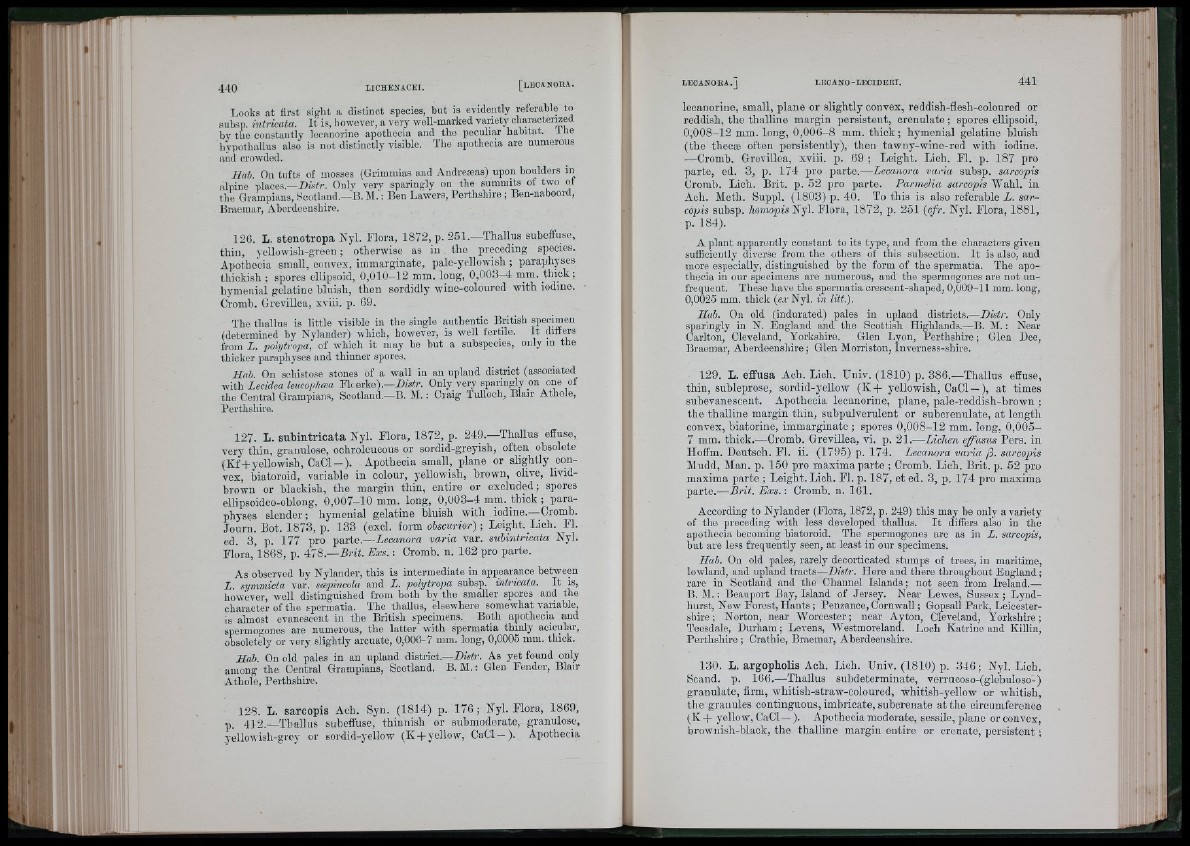
Looks at first sight a distinct species, but is evidently referable to
subsp. intricata. I t is, however, a veiy well-marked variety charajerized
by the constantly lecanorine apothecia and the peculiar habitat, tn e
livpotliallus also is not distinctly visible. The apothecia are numerous
and crowded.
Hub. On tiift.s of mosses (Griminias and Andreæas) upon boulders in
alpine places.—DisZr. Only very sparingly on the summits of two ot
the Grampians, Scotland.—B. AI. ; Ben Lawers, I’erthshire ; Ben-naboord,
Braeniar, Aberdeenshire.
126. L. s te n o tro p a Nyl. Flora, 1872, p. 251.—Thallus subeffuse,
th in , yellowish-greeu ; otherwise as in the preceding species.
A])otbecia small, convex, immarginate, pale-yellowisb ; paraphyses
thickish : spores ellipsoid, 0 ,0 1 0 -1 2 mm. long, 0 ,0 0 3 -4 mm. thick ;
bymeriial gelatine bluish, th en sordidly wine-coloured w ith iodine. ■
Cromb. Grevillea, xviii. p. 69.
The thallus is little visible in tlie single authentic British specimen
(determined by Nylander) which, however, is well fertile. I t differs
from L. polytropa, of which it may be but a subspecies, ouly m the
thicker paraphyses aud thinner spores.
Hab. On scHsto.se stones of a wall in an upland district (associated
with Lecidea leucophæa Fk erke).—DiSir. Only very spariugly on one ot
the Central Grampians, Scotlaud.—B. AI. : Craig Tulloch, Blair Athole,
I’erthshire.
127. L. suMntricata Nyl. Flora, 1872, p. 249.—Thallus effuse,
very th in , granulose, ochroleuoous or sordid-greyish, often obsolete
(K f+ y ellow ish , C a C l- ) . Apotbecia small, plane or slightly convex,
biatoroid, variable in colour, yellowish, brown, olive, livid-
brown or blaekisb, tb e margin th in , en tire or excluded; spores
ellipsoideo-oblong, 0 ,0 0 7 -1 0 mm.^ long, 0 ,0 0 3 -4 mm. thick ; p a ra physes
slender; hymenial gelatine bluish with iodine.—Cromb.
Journ. Bot. 1873, p. 133 (excl. iorva obscurior)-, Leight. Licb. Fl.
ed. 3, p. 177 pro p a rte .—Lecanora varia var. subintricata Nyl.
Flora,’l8 6 8 , p. 478.— Brit. Exs. : Cromb. n. 162 pro parte.
As observed by Nylander, this is intermediate in appearance betweeu
L . symmicta var. sæpincola and L. polytropa subsp. intricata. I t is,
however, well distinguished from both by the smaller spores and the
character of the spermatia. The thallus, elsewhere somewhat variable,
is almost evanescent in the British specimens. Both apothecia aud
spermogones are numerous, the latter with spermatia thinly acicuiar,
obsoletely or very slightly arcuate, 0,006-7 mm. long, 0,0005 mm. thick.
Hah. On old pales in an upland district.—Distr. As yet found only
among the Central Grampians, Scotland. B. AI. ; Glen Fender, Blair
Athole, Perthshire.
128. L. sa rco p is Ach. Syn. (1814) p. 1 7 6 ; Nyl. Flora, 1869,
p, 4 12.—Tballus subeffuse, thinnish or submoderate, granulose,
yellowish-grey or sordid-yellow (K + yellow, CaCl—). Apotheoia
leoanorine, small, plane or slightly convex, reddish-flesh-ooloured or
reddish, the thallino margin persistent, crenulate ; spores ellipsoid,
0,0 0 8 -1 2 mm. long, 0 ,0 0 6 -8 mm. thiok ; bymenial gelatine bluish
(th e thecæ often persistently), then tawny-wine-red with iodine.
—Cromb. Grovillea, xviii. p. 69 ; Leight. Lich. F l. p. 187 pro
parto, ed. 3, p. 174 pro p a rte .— Lecanora varia subsp. sarcopis
Cromb. Lioh. Brit. p. 52 pro parte. Parmelia sarcopis Wabl. in
Ach. Meth. Suppl. (1803) p. 40. To tbis is also referable L . sarcopis
subsp. homopis Nyl. Flora, 1872, p. 251 {cfr. Nyl. Flora, 1881,
p. 184).
A plant apparentlv constant to its type, and from tbe characters given
sufficiently diverse from the others of this subsection. I t is also, and
more especially, distinguished by the form of the spermatia. The apothecia
in our specimens are numerous, aud the spermogones are not imfrequent.
These have the spermatia crescent-shaped, 0,000-11 mm. long,
0,0025 mm. thick (eu,'Nyl. in litt.).
Hab. On old (indurated) pales in upland districts.—Distr. Only
sparingly in N. England and the, Scottish Highlands.—B. AI. ; Near
Carlton, Cleveland, Yorkshire. Glen Lyon, I’erthshire ; Glen Dee,
Braemai-, Aberdeenshire ; Gleu Morriston, Inverness-shire.
129. L. effusa Ach. Lioh. Univ. (1810) p. 386.—Thallus effuse,
thin, subleprose, sordid-yellow (K + yellowish, CaCl —), a t times
subevanescent. Apotheoia leoanorine, plane, pale-reddish-brown ;
tho th allin e margin th in , subpulverulent or suborenulate, a t length
convex, biatorine, immarginate ; spores 0 ,0 0 8 -1 2 mm. long, 0 ,0 0 5 -
7 mm. thiok.—Cromb. Grevillea, vi. p. 21.— Lichen effusus Pers. in
Hoffm. Deutsoh. F l. ii. (1795) p. 174. Lecanora varia /3. sarcopis
Mudd, Alan. p. 150 pro maxima p a rte ; Cromb. Lich. Brit. p. 52 pro
maxima parto ; Leight. Lioh. Fl. p. 187, et ed. 3, p. 174 pro maxima
pa rte .—B rit. Exs. : Cromb. n. 161.
According to Nylander (Flora, 1872, p. 249) this may he only a variety
of tlie preceding with less developed thaUus. I t differs also in the
apothecia becoming biatoroid. The spermogones are as iu L. sarcojiis,
but are le.«s frequently seen, at least in our specimens.
Hab. On old pales, rarely decorticated stumps of trees, in maritime,
lowland, and upland tracts—Distr. Here and there throughout England ;
rare in Scotland and the Chaunel Islands ; not seen from Ireland.—
B.AL; Beauport Bay, Island of Jersey. Near Lewes, Sussex; Lyndhurst,
New Forest, H ants ; Penzance, Cornwall ; Gopsall Park, Leicestershire;
Norton, near Worcester; near Ayton, Cleveland, Yorkshire;
Teesdale, Durham ; Levens, Westmoreland. Loch Katrine, and KiUin,
Perthshire ; Crathie, Braemar, Aberdeenshire.
130. L. argopholis Aob. Lieh. Univ. (181Ü) p. 346 ; Nyl. Lich.
Scand. p. 166.—Thallus subdeterminate, verrucoso-(glebuloso-)
granulate, firm, whitish-straw-coloured, whitish-yellow or whitish,
th e granules continguous, imbricate, subcrenate a t the circumferenoe
(K + yellow, CaCl — ). Apothecia moderate, sessile, plane or convex,
brownish-blaok, the thalline margin entire or crenate, persistent ;